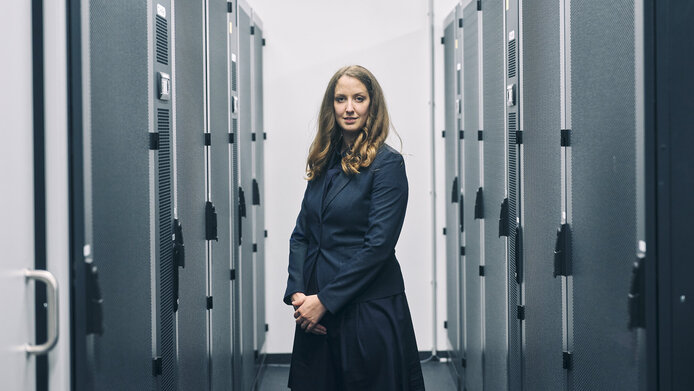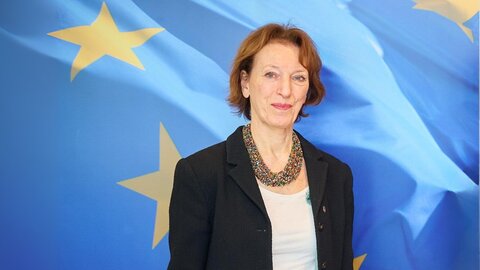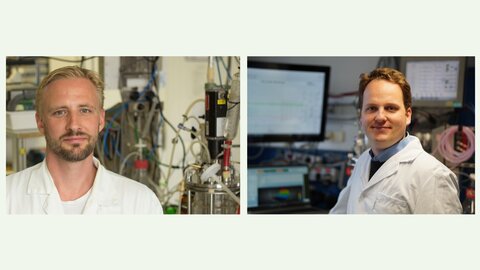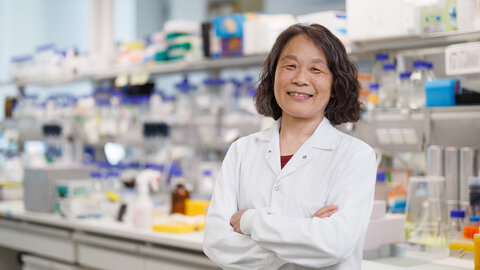A virtual laboratory for more sustainability

Ms. Heid, what is your project all about?
Esther Heid: My project is about the computer-assisted prediction of chemical reactions using machine learning. You can think of it as a virtual laboratory where you can carry out fast, efficient, and accurate computer simulations of chemical reactions at the touch of a button. And not just any reactions, but precisely those that we need to make chemistry more sustainable.
Machine learning already has many great applications in chemistry. But we’re lagging far behind when it comes to sustainability. We need better model architectures in machine learning – i.e. better program code, data sets, and connections to experiments – so that we can predict exactly why and how molecules react with each other.
Sustainability is particularly about selecting reactions that require little energy or produce little waste. For example, to produce a specific compound for a drug without additional – perhaps even toxic – by-products that have to be separated at great expense. Avoiding waste saves resources, protects the environment, and saves money.
One example of the type of reactions we want to investigate are enzymes in our own bodies, which act as biocatalysts to enable specific chemical reactions. The enzymes consist of different amino acids, but not all of them are active in all reactions. Or organocatalysts, which are smaller molecules in comparison. But even here, not all parts of the molecule are equally active or important.
This field of research is still relatively young and we simply do not have enough precise knowledge yet about how and why such reactions take place. Before we can calculate this with our new computer models and make predictions for new catalysts, we have to be able to incorporate the relationships between the various molecules involved into a computer algorithm. This is what we will be focusing on.
Personal details
Esther Heid studied chemistry from undergraduate to doctoral level at the University of Vienna, with a focus on theoretical chemistry. She spent time as a visiting researcher at Imperial College London and the University of Maryland, Baltimore, in the USA. As a postdoc, she worked for two years at the interface between chemistry and machine learning at the Massachusetts Institute of Technology (MIT), and since 2022 she has been a postdoc at TU Wien. Her research there includes new multi-enzyme reaction networks for the targeted production of molecules.
Why is this research relevant?
Heid: In our everyday lives, we use many things like medications, food additives, fertilizers, and fragrances, all of which have to be produced somehow, often not in a sustainable or environmentally friendly way. It’s also difficult to make changes because the development of sustainable processes is very slow and expensive. My project should make this much quicker.
We want to be able to predict reactions on the computer, so that we don't have to test all combinations of molecules and reactions experimentally, but only the most promising ones the computer spits out. This would make the research process much faster.
The topics of sustainability and the fair distribution of resources, which are also set out in the UN's Sustainable Development Goals, are hugely important. Researchers around the globe are working on them. For example, we hope that our research will make it possible to produce medications more cost-effectively, as their price plays an important role in health care in many countries.
What are the first steps in your project?
Heid: Although it’s a chemistry project, the first part won’t take place in the laboratory at all, but involves programming new machine learning models. We have to tailor these to the requirements of chemical reactions.
In particular, the aim is to find new representations for chemical reactions, so we can provide the computer with the necessary information in the first place. There is no consensus on the best way to do this for chemical reactions, and there are many different approaches with both advantages and disadvantages.
We would also like to integrate new findings from other areas of machine learning. For example, massive developments in large-language models like ChatGPT are emerging every year. The actual lab work comes later.
What will the START Award mean for your research activities?
Heid: I’ve only been a one-woman team up to now, but I have so many ideas about what could be explored. Now I can employ a team of doctoral students and postdocs. This means we can explore more in less time and tackle much more difficult goals than I could on my own.
For example, we can develop completely new computer models that will contribute to making chemistry more sustainable in larger steps instead of just making small improvements. Being able to pursue these major goals is really a dream come true for me, and this award is making it happen.
About the project
The “Deep Learning of Chemical Reactions” project aims to develop new machine learning algorithms that will allow researchers to find new chemical reactions and catalysts in a computer-based virtual laboratory in order to accelerate the search for sustainable approaches in chemistry.
What motivates you in your day-to-day research?
Heid: I am super curious and research gives me the opportunity to learn something new every day, often things that no one has ever known before. That simply fascinates me. What motivates me most is when someone tells me that something can’t be done. When we're sitting together at lunchtime and someone says that to me, I don't even listen to the rest of the conversation, but my brain is already rattling away with ideas of how it might work after all.
At the same time, it’s very important to me that these findings do not just land in a drawer somewhere, but create added value for others. For example, by making the world a little fairer, more resource-efficient, more environmentally friendly, or more livable for everyone.
How did you come to this field of research?
Heid: I originally studied chemistry at the University of Vienna, from bachelor's to master's to doctorate. I taught myself how to program. Then I went to MIT as a postdoc and continued my development in the field of machine learning and artificial intelligence. That's how I became a chemical programmer. This new research project now combines these two aspects: my love of both chemistry and programming.
There are a number of role models I have always looked up to, especially creative minds like Tess Smidt, Connor Coley, and William Green at MIT, Gerhard Zifferer at the University of Vienna, and my mentor Maricruz Sánchez-Sánchez at the TU Wien.
Having a high level of professional skills and supporting others is especially important to me. I'm not a fan of the dog-eat-dog mindset. Instead, I hope to encourage and empower others to achieve great things and accomplish more together than we can as individuals. The START Award combines this recognition of both performance and values.
The FWF START Award
The START program of the Austrian Science Fund (FWF) is aimed at outstanding young researchers, giving them the opportunity to plan their research in the long term and with a high degree of financial security. It is endowed with up to €1.2 million and is one of Austria’s most prestigious and most highly endowed awards alongside the FWF Wittgenstein Award.





